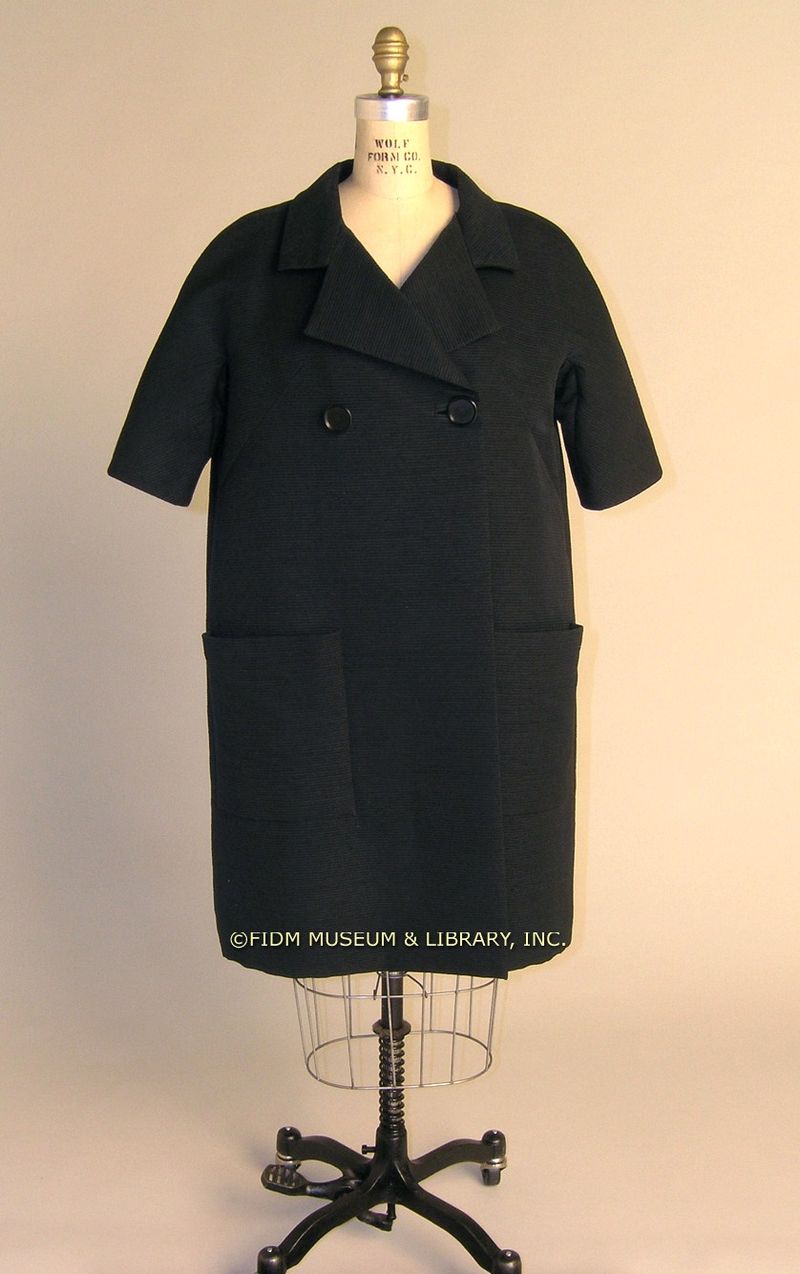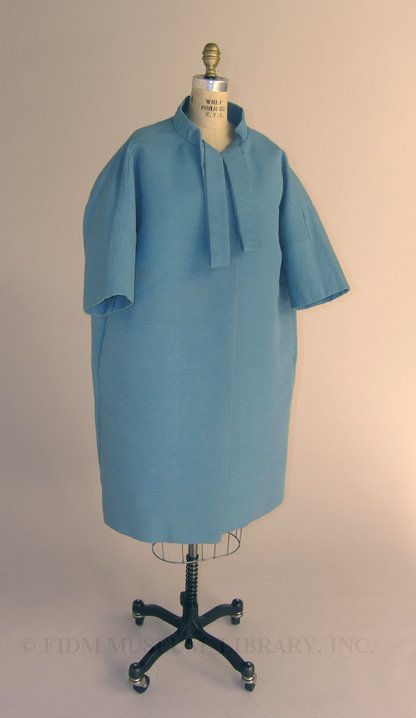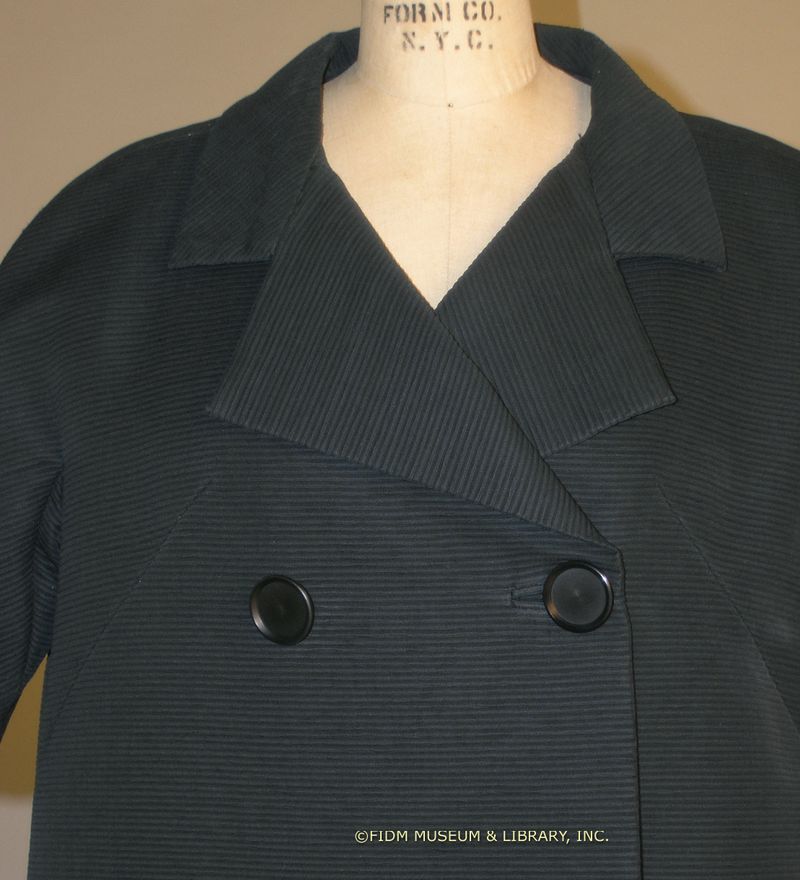Should fashion designers be able to protect their creative output with copyright protection? Regardless of your position on this issue, issues related to fashion and copyright keep appearing in the media. Just yesterday, fashion bloggers noticed that a costume designed by Jany Temime for the upcoming Harry Potter film is remarkably similar to an Alexander McQueen design. Responses to the similarity of these two gowns vary, from condemnation of Temime, to the suggestion that imitation is the sincerest form of flattery. The timing of this controversy is strangely coincidental, as today's planned post examines two similar 1950s coats: one designed by Balenciaga and one created by an unknown designer and retailed by I.Magnin. Though these coats differ in some important respects (color, collar detail), their similarities can be used to illustrate how copies of couture fashions were perceived in the 1950s.
 Balenciaga
Balenciaga
1957
Transfer from the Museum at FIT, Gift of Beth Levine
2004.291.13
The large barrel shape of this ribbed cotton coat is one of Cristobal Balenciaga's experiments in architectural form. From the early 1950s, Balenciaga experimented with a looser fit intended to flatter, rather than constrain, the body. Read more about Balenciaga's aesthetic in our post on Balenciaga's sack silhouette.
During the 1950s, copying of couture garments was both widespread and widely accepted. For the most part, this copying was regulated by the Chambre Syndicale, the governing body of French couture. Fashion buyers from Macy's, I.Magnin and other retailers attended the annual Paris fashion shows with the express purpose of purchasing finished garments, paper patterns or muslin toiles for copying. These couture designs were then manufactured for North American retail markets, often with variations designed to appeal to regional tastes. The resulting garments were generally advertised as being "line-for-line copies of famous Paris originals."1 Some retailers went even further, naming the designer of each garment, but specifically stating that the garments pictured were "American editions of Paris originals" by Balenciaga, Jacques Fath or another Paris couturier.2
Though the copying of couture garments was institutionalized during the 1950s, some designers were against the practice. In several late 1950s advertisements for "American editions," the designer is listed only as Monsieur X. Based on the design of the garments pictured, Monsieur X is probably Christian Dior. Was the use of an anonymous name intended to heighten interest in these copies, or was it indicative of one designer's uncomfortable relationship with copying?
Balenciaga also made some attempts to regulate copying of his garments. Though he allowed the purchase of finished garments by retailers for copying, in 1956 he banned fashion journalists from the fashion shows attended by individual clients and retail buyers. Journalists were invited to a show held one month after this first showing, long after other Paris shows had finished. Balenciaga made this move because he was frustrated by the appearance of his creations in newspapers and magazines so soon after their introduction to possible buyers. Unscrupulous manufacturers and retailers could simply copy the published descriptions and illustrations without purchasing the approved originals. By the time of the second fashion show, Balenciaga's employees had finished and delivered all garments ordered at the first, more private, showing. By forcing journalists to wait several weeks to see his creations, Balenciaga attempted to preserve both the mystique of his aesthetic and the profitability of his creations.

Unknown designer
I.Magnin
c. 1957
Gift of Mrs. Roxanne Wilson
S2003.1.3
Buyers often substantially modified Paris originals, based on a belief that "when new French clothes first appear, more often than not they strike the average women, with her immediate wardrobe needs in mind, as extreme and unwearable."3 Alterations could be as minor as changing the color and fabric, or geared towards simplifying a design for mass production. The blue coat pictured here, though not identical, is very similar in silhouette and textile to Balenciaga's coat of the same period. During the 1950s, Paris couture was still the center of the fashion world, influencing dress through both licensed and unlicensed copies of garments originating in Paris. Though we haven't found any evidence to suggest that this blue coat is an "American Edition of a Paris Original," its similarity to Balenciaga's design indicates the degree to which Paris fashion directly influenced garments made and worn in the United States.
1 Macy's advertisement. New York Times 18 Mar. 1956: 11.
2 "An Easy Story from Paris: Pleats, Flares, Drapery" New York Times 12 Sept. 1956: 43.
3 Howkins, Elizabeth. "How Paris Couture Affects American Design" New York Times 23 Aug. 1957: 22.




I think that intellectual property should be protected to some extent, including creative property. Our educational system requires us to identify quotes and authors in our research – the old school way of identifying an American interpretation of Monsier X could be fine tuned. Having said that, it’s funny how the presumption was that haute couture would have to be toned down for the American mass market. On a recent visit to Paris, I was noticing that the majority of French women I saw walking around the better neighborhoods were wearing classic pieces that were well tailored and fit their bodies exactly, rather than looking mass produced and ill fitting. Individualization was in the accessories. I’ve seen more trendy, throwaway, overdone clothing on women/fashion victims of all ages in L.A. Maybe it’s the provincial need to prove that we’re onto a style and can one up the original? With the exception of one older woman who I saw decked out in head to toe (classic subdued) Chanel every morning heading to the local Metro stop, I didn’t notice a lot of Parisiennes sporting in-your-face trends or obvious logo.